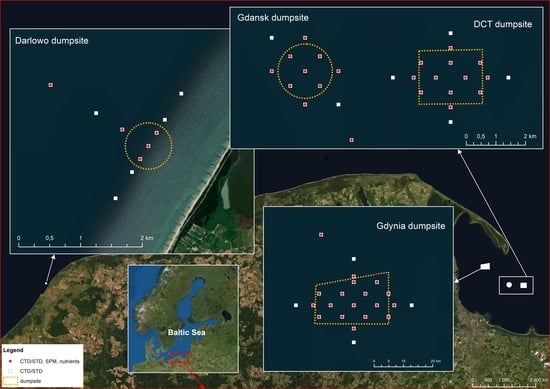Water Turbidity and Suspended Particulate Matter Concentration at Dredged Material Dumping Sites in the Southern Baltic
Abstract
1. Introduction
2. Materials and Methods
2.1. Dumping Sites
2.2. Turbidity Measurements
2.3. Biogenic Measurements
3. Results
3.1. Turbidity Depth Profiles
3.2. Concentrations of Nutrients
3.3. Turbidity in the Entire Water Columns and Tested Layers
3.4. Relationship between Turbidity and the SPM
4. Discussion
4.1. Turbidity and SPM Concentration at the Dumpsites and Reference Points
4.2. Concentrations of Nutrients in in the Bottom Layer
4.3. Limitations of Our Research and Recommendations for the Future Research
5. Conclusions
Author Contributions
Funding
Data Availability Statement
Acknowledgments
Conflicts of Interest
References
- Simonini, R.; Ansaloni, I.; Cavallini, F.; Graziosi, F.; Iotti, M.; N’Siala, G.M.; Mauri, M.; Montanari, G.; Preti, M.; Prevedelli, D. Effects of long-term dumping of dredged material on macrozoobenthos at four disposal sites along the Emilia-Romagna coast (Northern Adriatic Sea, Italy). Mar. Pollut. Bull. 2005, 50, 1595–1605. [Google Scholar] [CrossRef]
- Bolam, S.G.; Rees, H.L. Minimizing impacts of maintenance dredged material disposal in the coastal environment: A habitat approach. Environ. Manag. 2003, 32, 171–188. [Google Scholar] [CrossRef] [PubMed]
- Dembska, G.; Pazikowska-Sapota, G.; Bogdaniuk, M.; Blažauskas, N.; Suzdalev, S.; Zegarowski, L.; Hac, B.; Aftanas, B. Preliminary results of the analysis of dumping sites in SE Baltic region on example of Gdynia dumping site. In Proceedings of the Ocean: Past, Present and Future, 2012 IEEE/OES Baltic International Symposium (BALTIC), Klaipeda, Lithuania, 8–10 May 2012; pp. 1–7. [Google Scholar] [CrossRef]
- Mateo-Pérez, V.; Corral-Bobadilla, M.; Ortega-Fernández, F.; Rodríguez-Montequín, V. Analysis of the spatio-temporal evolution of dredging from satellite images: A case study in the principality of Asturias (Spain). J. Mar. Sci. Eng. 2021, 9, 267. [Google Scholar] [CrossRef]
- Staniszewska, M.; Boniecka, H. The environmental protection aspects of handling dredged material. Bull. Marit. Inst. 2015, 2, 60–70. [Google Scholar] [CrossRef][Green Version]
- Quang Tri, D.; Kandasamy, J.; Cao Don, N. Quantitative assessment of the environmental impacts of dredging and dumping activities at sea. Appl. Sci. 2019, 9, 1703. [Google Scholar] [CrossRef]
- Essink, K. Ecological effects of dumping of dredged sediments; options for management. J. Coast. Conserv. 1999, 5, 69–80. [Google Scholar] [CrossRef]
- HELCOM Guidelines for Management of Dredged Material at Sea. Available online: https://helcom.fi/wp-content/uploads/2016/11/HELCOM-Guidelines-for-Management-of-Dredged-Material-at-Sea.pdf (accessed on 25 March 2022).
- Stramski, D.; Bricaud, A.; Morel, A. Modeling the inherent optical properties of the ocean based on the detailed composition of planktonic community. Appl. Opt. 2001, 40, 2929–2945. [Google Scholar] [CrossRef] [PubMed]
- Morel, A.; Gentili, B.; Chami, M.; Ras, J. Bio-optical properties of high chlorophyll Case 1 waters and of yellow-substance-dominated Case 2 waters. Deep Sea Res. Part I Oceanogr. Res. Pap. 2006, 53, 1439–1459. [Google Scholar] [CrossRef]
- Stramski, D.; Babin, M.; Woźniak, S.B. Variations in the optical properties of terrigeneous mineral-rich particulate matter suspended in seawater. Limnol. Oceanogr. 2007, 52, 2418–2433. [Google Scholar] [CrossRef]
- Font, G.; Maňes, J.; Moltó, J.C.; Picó, Y. Solid-phase extraction in multi-residue pesticide analysis of water. J. Chromatogr. A 1996, 733, 449–471. [Google Scholar] [CrossRef]
- Soja-Woźniak, M.; Craig, S.E.; Kratzer, S.; Wojtasiewicz, B.; Darecki, M.; Jones, C.T. A novel statistical approach for ocean colour estimation of inherent optical properties and cyanobacteria abundance in optically complex waters. Remote Sens. 2017, 9, 343. [Google Scholar] [CrossRef]
- Murray, C.J.; Muller-Karulis, B.; Carstensen, J.; Conley, D.J.; Gustafsson, B.G.; Andersen, J.H. Past, present and future eutrophication status of the Baltic sea. Front. Mar. Sci. 2019, 6, 12. [Google Scholar] [CrossRef]
- Vigouroux, G.; Kari, E.; Beltran-Abaunza, J.M.; Uotila, P.; Yuan, D.K.; Destouni, G. Trend correlations for coastal eutrophication and its main local and whole-sea drivers-application to the Baltic sea. Sci. Total Environ. 2021, 779, 146367. [Google Scholar] [CrossRef] [PubMed]
- Lednicka, B.; Kubacka, M. Semi-empirical model of remote-sensing reflectance for chosen areas of the southern Baltic. Sensors 2022, 22, 1105. [Google Scholar] [CrossRef]
- Woźniak, S.B.; Meler, J.; Lednicka, B.; Zdun, A.; Stoń-Egiert, J. Inherent optical properties of suspended particulate matter in the southern Baltic sea. Oceanologia 2011, 53, 691–729. [Google Scholar]
- Ostrowska, M.; Darecki, M.; Krężel, A.; Ficek, D.; Furmańczyk, K. Practical applicability and preliminary results of the Baltic environmental satellite remote sensing system (Satbałtyk). Pol. Marit. Res. 2015, 22, 43–49. [Google Scholar] [CrossRef]
- Simpson, S.L.; Kumar, A. Chapter 4. sediment ecotoxicology. In Sediment Quality Assessment: A Practical Guide, 2nd ed.; Simpson, S.L., Batley, G.E., Eds.; CSIRO Publishing: Clayton South, Australia, 2016; pp. 77–122. Available online: http://hdl.handle.net/102.100.100/91039?index=1 (accessed on 25 March 2022).
- Proulx, I.; Hare, L. Differences in feeding behaviour among Chironomus species revealed by measurements of sulphur stable isotopes and cadmium in larvae. Freshw. Biol. 2014, 59, 73–86. [Google Scholar] [CrossRef]
- Operating Manual for STD/CTD Model SD204 with Sound Velocity & Optional Sensors. Available online: https://saiv.no/manuals/sd/SD204_manual_total.pdf (accessed on 25 March 2022).
- Model 606+ Multi-Parameter Logger with CTD; Valeport Limited: Devon, UK, 2002; Available online: https://envcoglobal.com/files/docs/midas-ctd-606-std-version-hardware0.pdf (accessed on 25 March 2022).
- Singh, A.; Than, A. Salinity, Temperature and turbidity structure in the Suva lagoon, Fiji. Am. J. Environ. Sci. 2008, 4, 266–275. [Google Scholar] [CrossRef]
- Polish Standardization Committee. PN-EN 872:2007+Ap1:2007. Water Quality-Determination of Suspended Solids-Method Using Filtration through Glass Fiber Filters (In Polish). Available online: https://sklep.pkn.pl/pn-en-872-2007p.html (accessed on 13 May 2022).
- Grasshoff, K.; Kremling, K.; Ehrhardt, M. Methods of Seawater Analysis, 3rd ed.; Wiley-VCH: Weinheim, Germany, 1999; p. 632. [Google Scholar]
- Pilkaityte, R.; Raznikovas-Baziukas, A. Seasonal changes in phytoplankton composition and nutrient limitation in a shallow Baltic lagoon. Boreal Environ. Res. 2007, 12, 551–559. [Google Scholar]
- Elovaara, S.; Degerlund, M.; Franklin, D.J.; Kaartoallio, H.; Tamelander, T. Seasonal variation in estuarine phytoplankton viability and its relationship with carbon dynamics in the Baltic sea. Hydrobiologia 2020, 847, 2485–2501. [Google Scholar] [CrossRef]
- State of the Environment. Water Monitoring. Surface Waters. Assessment of the Status of Transitional and Coastal Water Bodies in 2014–2019 (In Polish). Report of the Polish Chief Inspectorate of Environmental Protection. 2019. Available online: https://www.gios.gov.pl/images/dokumenty/pms/monitoring_wod/Klasyfikacja_i_ocena_stanu_TW_CW_2014-2019.xlsx (accessed on 25 March 2022).
- Zalewska, T.; Kraśniewski, W. Ocena Stanu Środowiska Morskiego Polskiej Strefy Ekonomicznej Bałtyku na Podstawie Danych Monitoringowych z Roku 2018 na tle Dziesięciolecia 2008–2017; Biblioteka Monitoringu Środowiska: Warsaw, Poland, 2019. [Google Scholar]
- Krzymiński, W. Ocena Stanu Środowiska Morskiego Polskiej Strefy Ekonomicznej Bałtyku na Podstawie Danych Monitoringowych z Roku 2016 na tle Dziesięciolecia 2006–2015; Biblioteka Monitoringu Środowiska: Warsaw, Poland, 2017. [Google Scholar]
- Stedmon, C.A. Monitoring Cruise Report Cruise No.: GT 244, 4–8 February 2008, The Sound, the Arkona Sea, the Belt Sea and the Kattegat; National Environmental Research Institute University of Aarhus: Roskilde, Denmark, 2008; p. 17. [Google Scholar]
- Gustafsson, B.G. Quantification of water, salt, oxygen and nutrient exchange of the Baltic Sea from observations in the Arkona Basin. Cont. Shelf Res. 2001, 21, 1485–1500. [Google Scholar] [CrossRef]
- Wasmund, N.; Dutz, J.; Pollehne, F.; Siegel, H.; Zettler, M.L. Biological Assessment of the Baltic Sea 2016; Marine Science Reports; Meereswissenschaftliche Berichte: Warnemünde, Germany, 2017; pp. 1–174. [Google Scholar] [CrossRef]
- Wasmund, N.; Holtermann, P.; Osma, N.; Fernández-Urruzola, I.; Kolbe, M.; Donath, J.; Poetzsch, M.; Jeschek, J.; Kreuzer, L.; Merz, E.; et al. Cruise Report r/v “Elisabeth Mann Borgese”. Cruise-No. EMB 154. Monitoring Cruise 9 May–19 May 2017; Kiel to Northern Baltic Proper; Leibniz Institute for Baltic Sea Research, Leibniz-Institut für Ostseeforschung Warnemünde, Universität: Rostock, Germany, 2017. [Google Scholar]
- Berthold, M.; Karsten, U.; von Weber, M.; Bachor, A.; Schumann, R. Phytoplankton can bypass nutrient reductions in eutrophic coastal water bodies. Ambio 2018, 47 (Suppl. S1), 146–158. [Google Scholar] [CrossRef] [PubMed]
- Kari, E.; Kratzer, S.; Beltran-Abaunza, J.M.; Harvey, E.T.; Vaiciute, D. Retrieval of suspended particulate matter from turbidity-model development, validation, and application to MERIS data over the Baltic sea. Int. J. Remote Sens. 2017, 38, 1983–2003. [Google Scholar] [CrossRef]
- Meler, J.; Ostrowska, M.; Ston-Egiert, J. Seasonal and spatial variability of phytoplankton and non-algal absorption in the surface layer of the Baltic. Estuar. Coast. Shelf Sci. 2016, 180, 123–135. [Google Scholar] [CrossRef]
- Woźniak, S.B.; Meler, J.; Ston-Egiert, J. Inherent optical properties of suspended particulate matter in the southern Baltic Sea in relation to the concentration, composition and characteristics of the particle size distribution; new forms of multicomponent parameterizations of optical properties. J. Mar. Syst. 2022, 229, 103720. [Google Scholar] [CrossRef]
- Constantin, S.; Constantinescu, S.; Doxaran, D. Long-term analysis of turbidity patterns in Danube Delta coastal area based on MODIS satellite data. J. Mar. Syst. 2017, 170, 10–21. [Google Scholar] [CrossRef]
- Dzierzbicka-Głowacka, L.; Musialik, M.; Kalarus, M.; Lemieszek, A.; Prątnicka, P.; Janecki, M.; Żmijewska, M. The interannual changes in the secondary production and mortality rate of main copepod species in the gulf of Gdańsk (the southern Baltic sea). Appl. Sci. 2019, 9, 2039. [Google Scholar] [CrossRef]
- Jafar-Sidik, M.; Gohin, F.; Bowers, D.; Howarth, J.; Hull, T. The relationship between suspended particulate matter and turbidity at a mooring station in a coastal environment: Consequences for satellite-derived products. Oceanologia 2017, 59, 365–378. [Google Scholar] [CrossRef]
- Razali, N.M.; Wah, Y.B. Power comparisons of Shapiro-wilk, Kolmogorov Smirnov, Lilliefors and Anderson-darling tests. J. Stat. Model. Anal. 2011, 2, 21–33. [Google Scholar]
- Regulation on the Classification of Ecological Status, Ecological Potential, Chemical Status and the Method of Classifying the Status of Surface Water Bodies as Well as Environmental Quality Standards for Priority Substances. 2019. Available online: https://leap.unep.org/countries/pl/national-legislation/regulation-classification-ecological-status-ecological-1 (accessed on 25 March 2022).
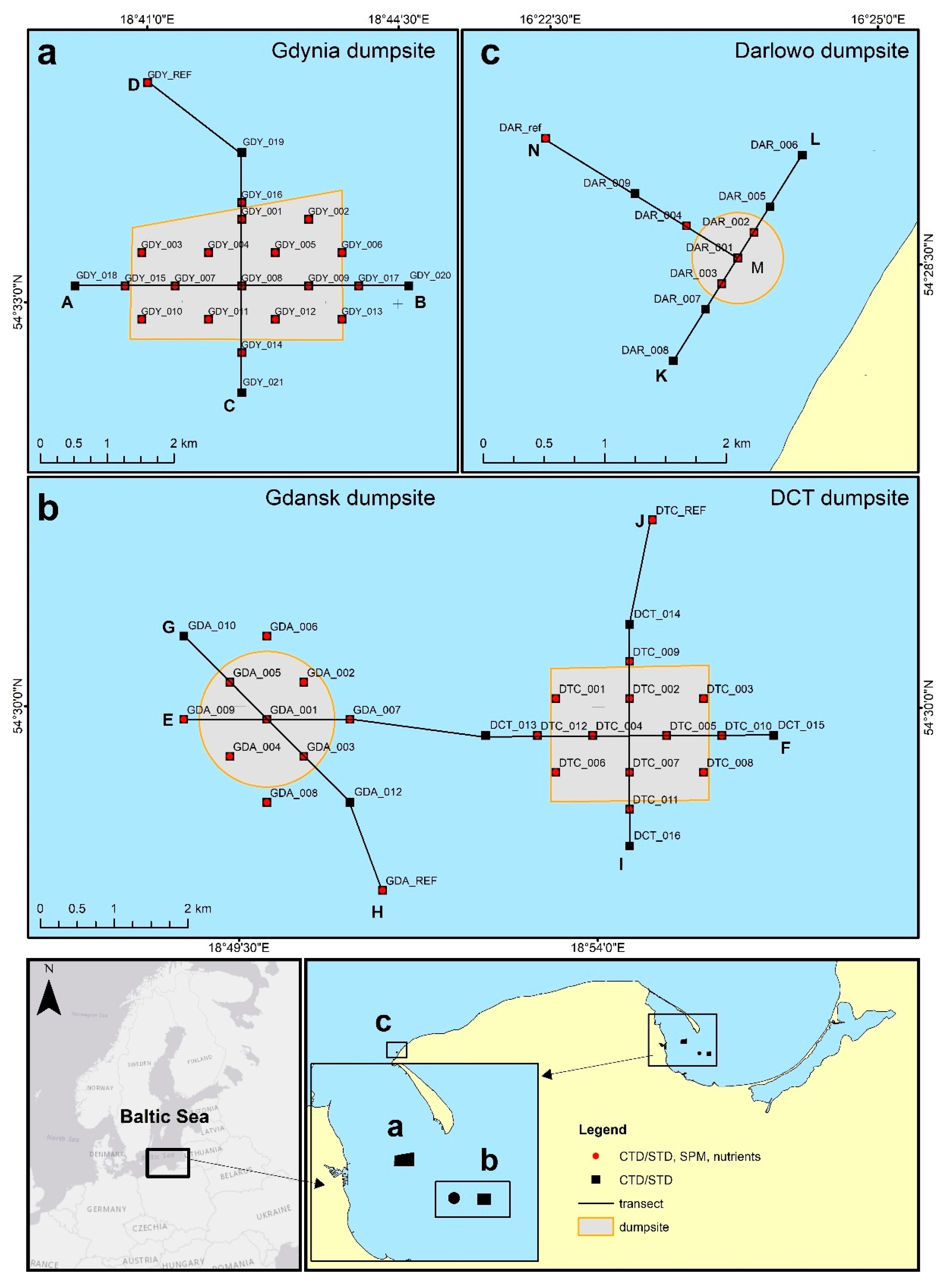
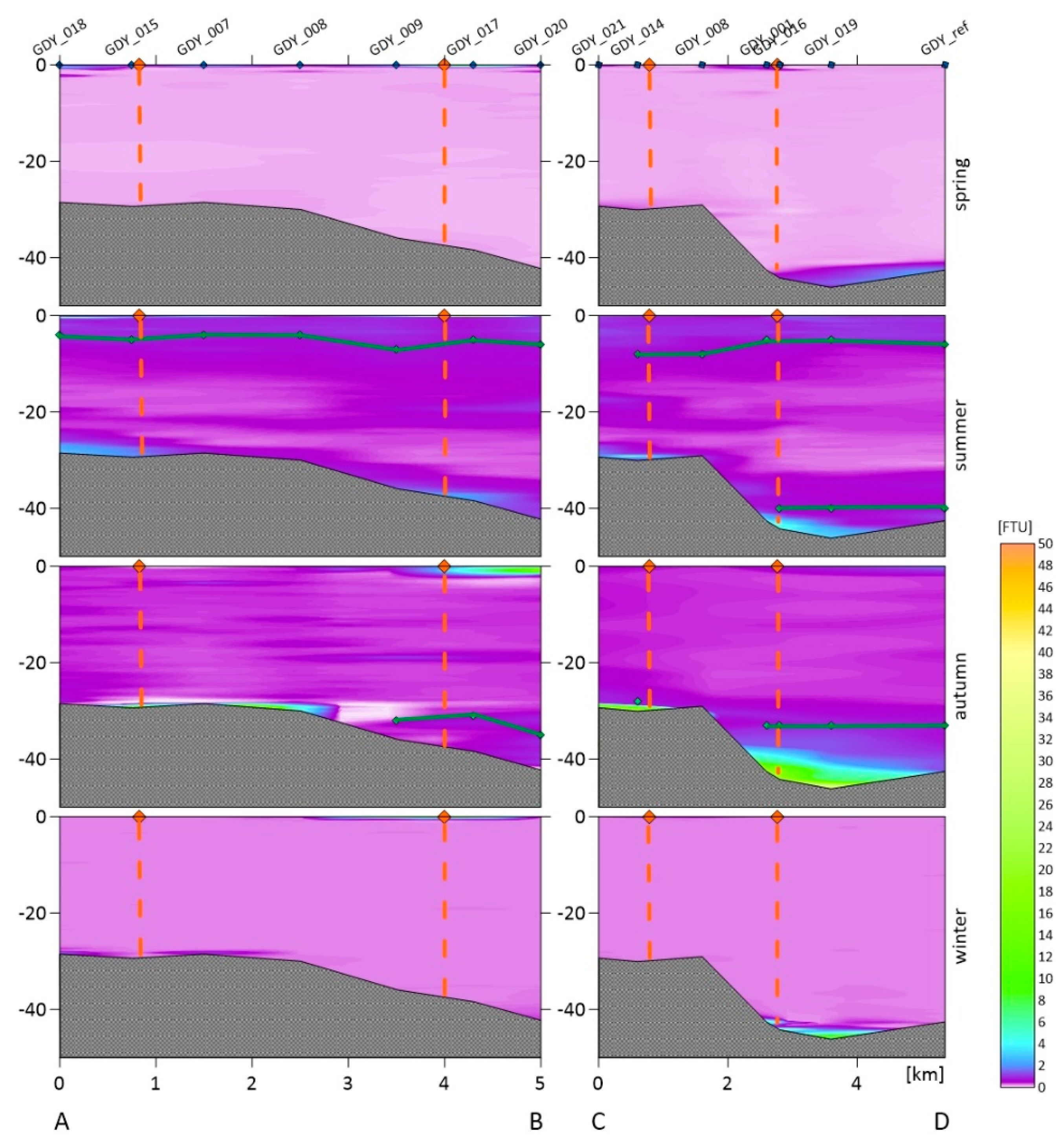


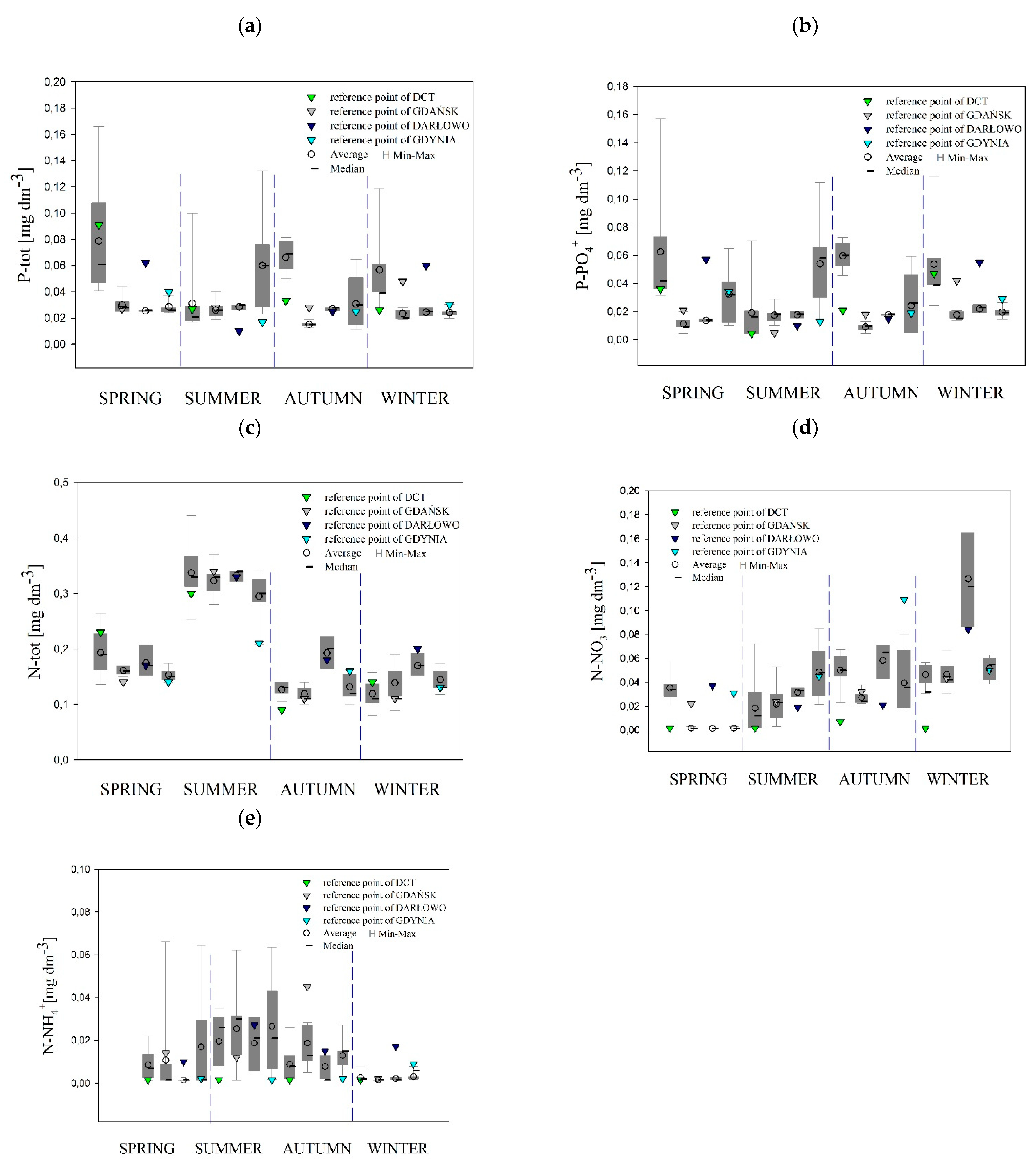

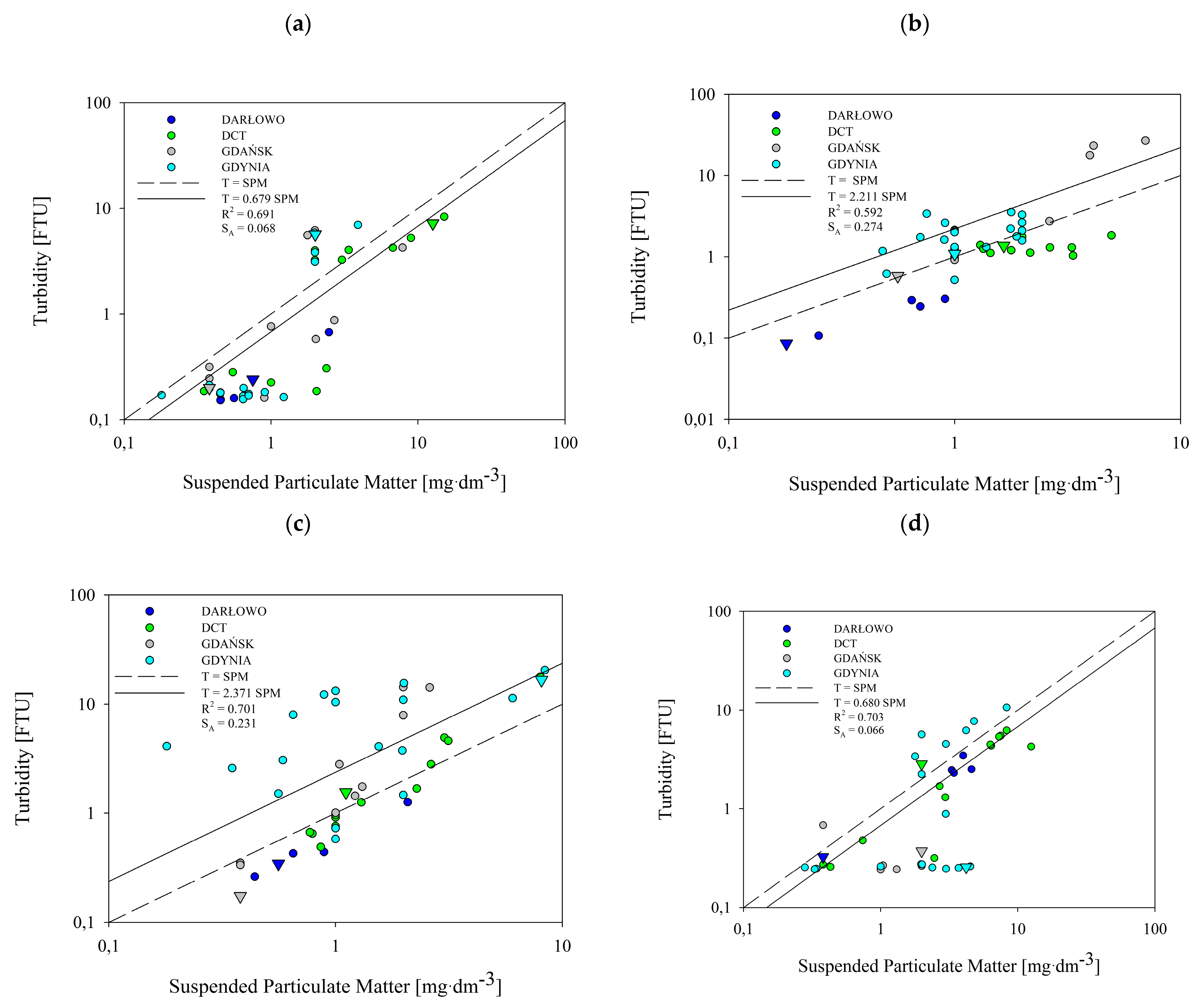
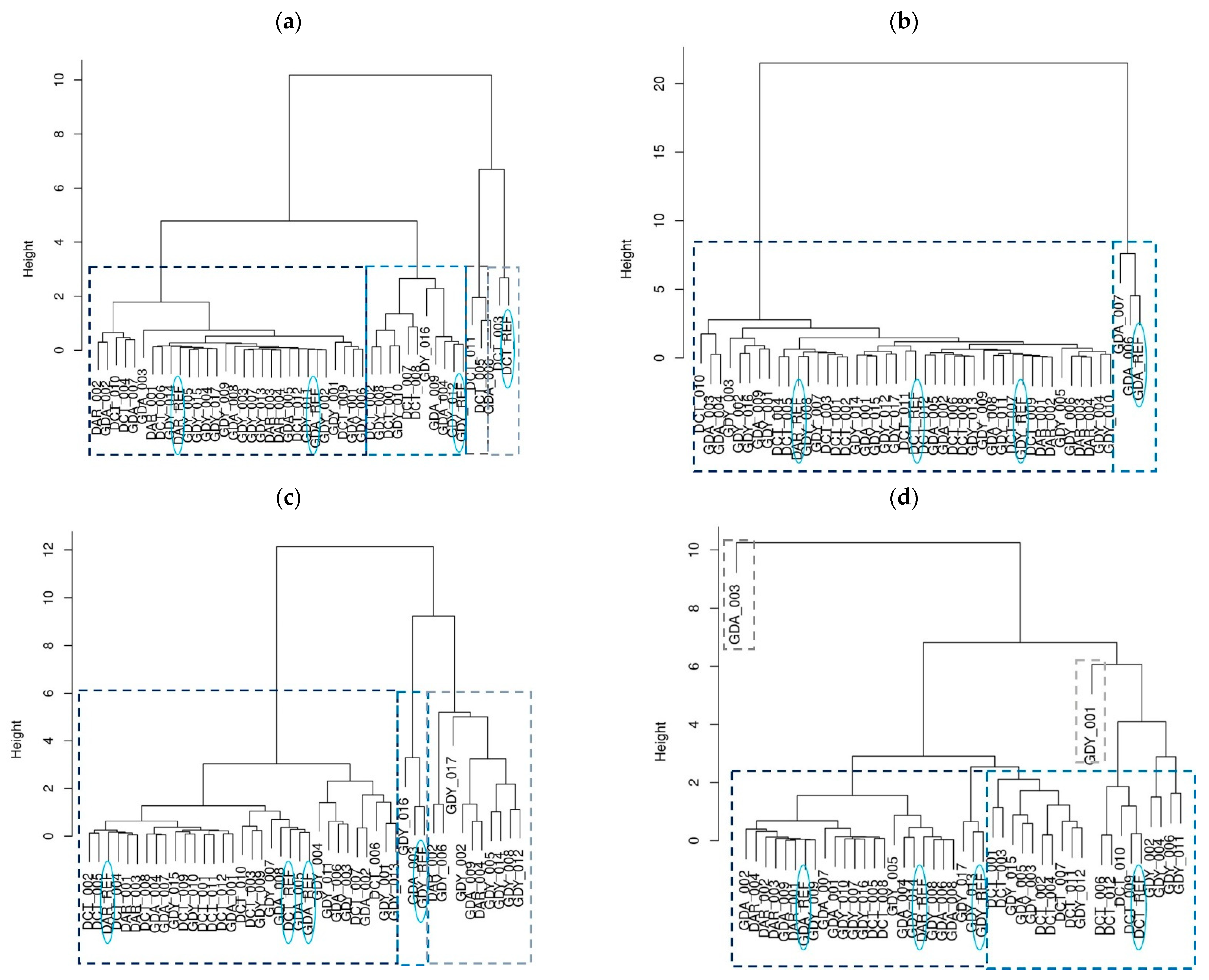
| Transect | Dumpsite | Measurement Points | Length | Course |
|---|---|---|---|---|
| AB | Gdynia | GDY_018, GDY_015, GDY_007, GDY_008, GDY_009, GDY_017, and GDY_020 | 5.0 km | W–E |
| CD | Gdynia | GDY_021, GDY_014, GDY_008, GDY_001, GDY_016, GDY_019, and GDY_ref | 3.6 km | S–N |
| EF | Gdańsk, DCT | GDA_009, GDA_001, GDA_007, DCT_013, DCT_012, DCT_004, DCT_005, DCT_010, and DCT_015 | 8.0 km | W–E |
| GH | Gdańsk | GDA_010, GDA_005, GDA_001, GDA_003, GDA_012, and GDA_ref | 4.45 km | NW–SE |
| IJ | DCT | DCT_016, DCT_011, DCT_007, DCT_002, DCT_009, DCT_014, and DCT_ref | 3.9 km | S–N |
| KL | Darłowo | DAR_008, DAR_007, DAR_003, DAR_001, DAR_002, DAR_005, and DAR_006 | 2.0 km | SW–NE |
| MN | Darłowo | DAR_001, DAR_004, DAR_009, and DAR_ref | 2.0 km | SE–NW |
| Sea Dumping Site | Season | N-tot (mg∙dm−3) | N-NO3− (mg∙dm−3) | N-NH4+ (mg∙dm−3) | P-tot (mg∙dm−3) | P-PO4−3 (mg∙dm−3) |
|---|---|---|---|---|---|---|
| Gdynia | Spring | 0.15/0.14 | <0.003/<0.003 | 0.017/< 0.003 | 0.028/0.026 | 0.032/0.047 |
| Summer | 0.33/0.28 | 0.025/0.032 | 0.025/0.030 | 0.032/0.030 | 0.022/0.020 | |
| Autumn | 0.13/0.16 | 0.040/0.084 | 0.013/0.017 | 0.031/0.060 | 0.024/0.055 | |
| Winter | 0.14/0.13 | 0.052/0.050 | <0.003/0.009 | 0.024/0.030 | 0.020/0.029 | |
| Gdańsk | Spring | 0.16/0.14 | <0.003/<0.003 | 0.011/<0.003 | 0.029/0.027 | 0.011/0.007 |
| Summer | 0.32/0.29 | 0.028/0.026 | 0.027/0.030 | 0.027/0.024 | 0.022/0.016 | |
| Autumn | 0.12/0.11 | 0.027/0.019 | 0.019/0.027 | 0.015/0.010 | 0.009/0.010 | |
| Winter | 0.14/0.11 | 0.047/0.045 | <0.003/<0.003 | 0.023/0.017 | 0.018/0.013 | |
| DCT | Spring | 0.19/0.23 | 0.035/< 0.003 | 0.009/<0.003 | 0.079/0.091 | 0.062/0.036 |
| Summer | 0.29/0.21 | 0.059/0.043 | 0.025/<0.003 | 0.075/0.048 | 0.066/0.042 | |
| Autumn | 0.12/0.14 | 0.049/0.048 | 0.009/<0.003 | 0.066/0.069 | 0.060/0.062 | |
| Winter | 0.12/0.14 | 0.046/0.031 | <0.003/<0.003 | 0.057/0.040 | 0.054/0.034 | |
| Darłowo | Spring | 0.18/0.17 | <0.003/0.007 | <0.003/<0.003 | 0.026/0.033 | 0.014/0.021 |
| Summer | 0.34/0.28 | <0.003/<0.003 | 0.008/0.004 | 0.018/0.018 | <0.009/0.016 | |
| Autumn | 0.19/0.18 | 0.058/0.021 | 0.008/0.015 | 0.027/0.025 | 0.018/0.015 | |
| Winter | 0.17/0.20 | 0.126/0.109 | <0.003/<0.003 | 0.024/0.025 | 0.022/0.019 |
| Sea Dumping Site | Season | Turbidity (Surface Layer) (FTU) | Turbidity (Seabed Layer) (FTU) | Turbidity in the Entire Water Column (FTU) | SPM (Surface Layer) (mg∙dm−3) | SPM (Seabed Layer) (mg∙dm−3) |
|---|---|---|---|---|---|---|
| Gdynia | Spring | 3.74/0.30 | 1.30/5.68 | 0.36/1.70 | 2.72/0.44 | 2.81/2.00 |
| Summer | 1.40/1.01 | 1.97/1.09 | 0.68/0.55 | 1.87/1.00 | 3.07/1.00 | |
| Autumn | 3.37/13.21 | 7.29/16.60 | 1.59/1.13 | 5.19/6.66 | 5.64/8.10 | |
| Winter | 2.28/0.24 | 2.56/0.26 | 0.55/0.25 | 2.16/0.38 | 2.72/4.20 | |
| Gdańsk | Spring | 3.53/7.73 | 2.11/0.20 | 0.28/0.39 | 2.89/1.78 | 2.11/0.38 |
| Summer | 2.75/1.67 | 8.66/0.58 | 1.40/0.55 | 3.49/2.34 | 2.52/0.56 | |
| Autumn | 0.91/0.72 | 4.90/0.17 | 1.09/0.27 | 0.87/1.99 | 1.32/0.38 | |
| Winter | 0.30/1.84 | 0.30/0.37 | 0.26/0.28 | 0.37/0.46 | 1.19/1.99 | |
| DCT | Spring | 1.29/2.00 | 2.80/7.23 | 0.25/0.16 | 2.00/1.00 | 3.96/12.56 |
| Summer | 1.25/0.98 | 1.27/1.37 | 0.38/0.33 | 2.41/2.30 | 2.19/1.65 | |
| Autumn | 3.65/0.37 | 3.13/1.55 | 0.37/0.37 | 2.07/0.48 | 2.17/1.55 | |
| Winter | 2.61/0.25 | 2.88/2.84 | 0.34/0.77 | 2.14/0.38 | 4.80/<2.84 | |
| Darłowo | Spring | 3.85/4.79 | 0.29/0.24 | 0.40/0.41 | 4.15/1.24 | 0.99/0.24 |
| Summer | 0.44/0.67 | 0.24/0.09 | 0.25/0.11 | 0.55/1.10 | 0.63/0.09 | |
| Autumn | 5.35/4.22 | 0.60/0.34 | 0.30/0.23 | 3.28/2.48 | 1.00/0.34 | |
| Winter | 1.78/9.90 | 2.69/0.33 | 0.42/0.55 | 4.88/8.50 | 3.83/0.38 |
| Sea Dumping Site/Number of Sampling Points | Season | Turbidity in Surface Layer (%) | Turbidity in Bottom Layer (%) | SPM in Surface Layer (%) | SPM in Bottom Layer (%) |
|---|---|---|---|---|---|
| Gdynia 17 | Spring | 88 | 12 | 82 | 6 |
| Summer | 35 | 88 | 47 | 65 | |
| Autumn | 0 | 6 | 0 | 6 | |
| Winter | 100 | 65 | 88 | 24 | |
| Gdańsk 9 | Spring | 22 | 89 | 56 | 100 |
| Summer | 78 | 100 | 67 | 100 | |
| Autumn | 33 | 100 | 0 | 100 | |
| Winter | 0 | 11 | 22 | 11 | |
| DCT 12 | Spring | 25 | 8 | 75 | 8 |
| Summer | 83 | 25 | 58 | 58 | |
| Autumn | 92 | 42 | 92 | 50 | |
| Winter | 92 | 50 | 92 | 75 | |
| Darłowo 4 | Spring | 25 | 25 | 75 | 25 |
| Summer | 0 | 100 | 0 | 100 | |
| Autumn | 50 | 75 | 50 | 75 | |
| Winter | 0 | 100 | 0 | 100 |
| Sea Dumping Site/Number of Sampling Points | Critical Values | Season | WSPM Surface tSPM Surface | WT Surface tT Surface | WSPM Bottom tSPM Bottom | WSPM Bottom tSPM Bottom |
|---|---|---|---|---|---|---|
| Gdynia 17 | 0.892 2.120 | Spring | 0.699 | 0.660 | 0.746 | 0.581 |
| - | - | - | - | |||
| Summer | 0.813 | 0.611 | 0.861 | 0.957 | ||
| - | - | - | 0.981 | |||
| Autumn | 0.751 | 0.850 | 0.653 | 0.903 | ||
| - | - | - | −1.560 | |||
| Winter | 0.939 | 0.774 | 0.90 | 0.76 | ||
| 1.306 | - | −0.726 | - | |||
| Gdańsk 9 | 0.829 2.306 | Spring | 0.821 | 0.716 | 0.709 | 0.749 |
| - | - | - | - | |||
| Summer | 0.948 | 0.858 | 0.770 | 0.723 | ||
| 0.606 | 0.825 | - | - | |||
| Autumn | 0.824 | 0.588 | 0.936 | 0.757 | ||
| - | - | 1.259 | - | |||
| Winter | 0.944 | 0.633 | 0.845 | 0.46 | ||
| −0.611 | - | −1.571 | - | |||
| DCT 12 | 0.859 2.201 | Spring | 0.880 | 0.875 | 0.768 | 0.859 |
| 0.691 | −0.632 | - | −1.697 | |||
| Summer | 0.882 | 0.901 | 0.879 | 0.888 | ||
| 0.184 | 0.876 | 0.452 | −0.355 | |||
| Autumn | 0.855 | 0.674 | 0.685 | 0.573 | ||
| - | - | - | - | |||
| Winter | 0.761 | 0.717 | 0.92 | 0.85 | ||
| - | - | 0.564 | - | |||
| Darłowo 4 | 0.748 3.182 | Spring | 0.800 | 0.991 | 0.668 | 0.640 |
| 0.598 | −0.305 | - | - | |||
| Summer | 0.964 | 0.989 | 0.938 | 0.837 | ||
| −2.194 | −1.738 | 1.624 | 1.674 | |||
| Autumn | 0.820 | 0.855 | 0.844 | 0.781 | ||
| 0.396 | 0.468 | 0.620 | 0.564 | |||
| Winter | 0.919 | 0.887 | 0.92 | 0.78 | ||
| −1.958 | −6.990 | 5.775 | 4.478 |
| Sea Dumping Site | Critical Value of the Kruskal–Wallis Test | HSPM Surface | HT Surface | HSPM Bottom | HT Bottom |
|---|---|---|---|---|---|
| Gdynia | 7.815 | 2.213 | 2.801 | 11.260 | 24.305 |
| Gdańsk | 18.631 | 13.829 | 1.375 | 17.867 | |
| DCT | 2.707 | 0.962 | 3.335 | 0.961 | |
| Darłowo | 8.140 | 8.670 | 8.625 | 10.478 |
Publisher’s Note: MDPI stays neutral with regard to jurisdictional claims in published maps and institutional affiliations. |
© 2022 by the authors. Licensee MDPI, Basel, Switzerland. This article is an open access article distributed under the terms and conditions of the Creative Commons Attribution (CC BY) license (https://creativecommons.org/licenses/by/4.0/).
Share and Cite
Lednicka, B.; Kubacka, M.; Freda, W.; Haule, K.; Dembska, G.; Galer-Tatarowicz, K.; Pazikowska-Sapota, G. Water Turbidity and Suspended Particulate Matter Concentration at Dredged Material Dumping Sites in the Southern Baltic. Sensors 2022, 22, 8049. https://doi.org/10.3390/s22208049
Lednicka B, Kubacka M, Freda W, Haule K, Dembska G, Galer-Tatarowicz K, Pazikowska-Sapota G. Water Turbidity and Suspended Particulate Matter Concentration at Dredged Material Dumping Sites in the Southern Baltic. Sensors. 2022; 22(20):8049. https://doi.org/10.3390/s22208049
Chicago/Turabian StyleLednicka, Barbara, Maria Kubacka, Włodzimierz Freda, Kamila Haule, Grażyna Dembska, Katarzyna Galer-Tatarowicz, and Grażyna Pazikowska-Sapota. 2022. "Water Turbidity and Suspended Particulate Matter Concentration at Dredged Material Dumping Sites in the Southern Baltic" Sensors 22, no. 20: 8049. https://doi.org/10.3390/s22208049
APA StyleLednicka, B., Kubacka, M., Freda, W., Haule, K., Dembska, G., Galer-Tatarowicz, K., & Pazikowska-Sapota, G. (2022). Water Turbidity and Suspended Particulate Matter Concentration at Dredged Material Dumping Sites in the Southern Baltic. Sensors, 22(20), 8049. https://doi.org/10.3390/s22208049








